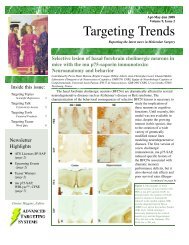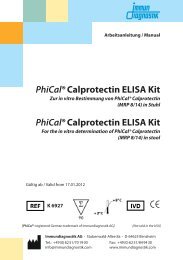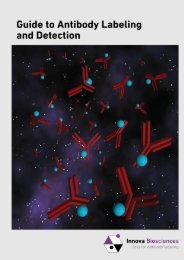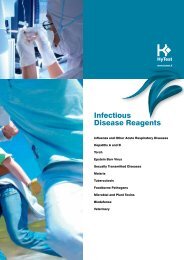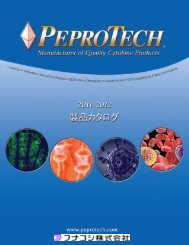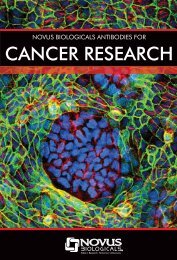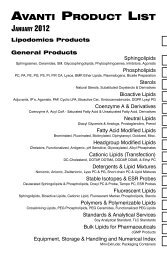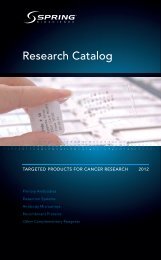Minicircles - System Biosciences
Minicircles - System Biosciences
Minicircles - System Biosciences
Create successful ePaper yourself
Turn your PDF publications into a flip-book with our unique Google optimized e-Paper software.
SBINSIGHTS<strong>Minicircles</strong>: The NextGeneration of PlasmidsProduce Your Own<strong>Minicircles</strong> with theMC-Easy MinicircleProduction kitIssue.05The Development of<strong>Minicircles</strong>, Interviewwith Inventor Mark Kay,M.D., Ph.DACCELERATING DISCOVERIES THROUGH INNOVATIONSwww.systembio.com
Hot Topics 2<strong>Minicircles</strong>: The Next Generation ofPlasmidsTips and Techniques 4Production of Minicircle DNA usingSBI's MC-Easy KitPartnerships 6The Development of <strong>Minicircles</strong>,Mark Kay, M.D., Ph.D., Stanford UniversityMeet SBI 8Zhihong Sun, M.D.Research Associate, Production andCustom ServicesAnnouncements 10
mRNAExpressmRNA Synthesis KitOnly FromTranscribe and Deliver mRNA into Cells for Rapid ExpressionGenerate Highly Concentrated Synthetic mRNAsSBI's mRNAExpress mRNA Synthesis Kit is designed for invitro transcription of mRNAs to be used for transfection ofmammalian cells, oocyte micro-injections, in vitrotranslation and other applications. Each reaction canproduce 20-40g RNA. Positive control mRNAs for GFP andRFP as well as pre-made mRNAs for MyoD, Nanog, Oct4,Sox2, Lin28, Klf4 and c-Myc are also available.Positive Control mRNAs for GFP andRFP to Track your RNAFectionsEach mRNAExpress Kit comes complete with:• pMRNA xp T7 promoter, poly-A tail cloning vector• Robust T7 RNA polymerase• Anti-reverse ARCA cap analog• Modified nucleotide triphosphates• DNase & phosphatase• RNA purification spin columnsFind out more:www.systembio.com/mrnaexpress650-968-2200 • info@systembio.comGFP (cat# MR700A-1)RFP (cat# MR800A-1)mRNAExpress MyoD mRNA (cat# MR900A-1)Transdifferentiates Skin into MyocytesDesmin stainBinucleatedmyocyteDesmin/DAPI merge
HOT TOPICS<strong>Minicircles</strong>: TheNext Generation ofPlasmids<strong>Minicircles</strong> (MC) are circular DNA elements that no longer contain antibiotic resistance markers or thebacterial origin of replication. These small vectors can be used in vivo or in vitro and provide for long-termtransient expression of one or more transgenes without the risk of immunogenic responses that can becaused by the bacterial backbone in standard plasmids. <strong>Minicircles</strong> are typically expressed for a period ofseveral weeks, without integrating into the host cell genome, thus preventing unwanted genomic changesin the cells.Minicircle versus Traditional Plasmid StructureTraditional plasmids have a bacterial backbone portion that contains the origin of replication and anantibiotic resistance gene, which are use for propagation of the plasmid in bacterial culture. Additionally,they have the necessary promoters, transgenes, and reporter genes used for expression of the transgene inthe target cells. While the bacterial portions of the plasmid are necessary for propagation, they can causeimmune reactions in the target cells which direct the plasmids to degradation pathways. The host cellsbasically recoginze the bacterial portion of the plasmids as "foreign" and thus destroy it, allowing for only ashort expression time of the transgene. Some plasmids also contain a mammalian antibiotic selection markerwhich facilitates integration of the plasmid into the host cell genome, thus prolonging the expression of thetransgene, but causing integration into random sites within the chromosome, which can cause unwantedchanges in the host cell.The Components of the Minicircle <strong>System</strong><strong>Minicircles</strong> are devoid ofthe bacterial portions of theplasmid. So while minicirclescannot replicate or integrateinto the target cells, they areexpressed for a longer periodof time because there is nobacterial backbone directingthe plasmids to a degradationpathway. Since they do notintegrate into the host cellgenome, there is no risk of themcausing unwanted permanentchanges in the cells resultingfrom integrating into randomsites in the genome.Production of minicircles requires a special parental plasmid (PP-DNA) and an engineered E. coli strain(ZYCY10P3S2T E. coli) that allows both propagation of the parental plasmid and the production of theminicircles. <strong>Minicircles</strong> are conditionally generated by an expression of inducible ФC31 integrase viaintramolecular (cis-) recombination.2 www.systembio.com
HOT TOPICSThe full-size PP-DNA construct is grown in ZYCY10P3S2T E. coli that harbor an arabinose-inducible system toexpress the ФC31 integrase and the I-SceI endonuclease simultaneously. The ФC31 integrase produces theMC-DNA molecules and bacterial backbone DNA from the full-size PP-DNA upon arabinose induction. Thebacterial backbone contains a number of engineered I-SceI restriction sites that are subject to the digestionof I-SceI endonuclease and ultimate destruction of the bacterial backbone. The MC-DNA is lacking I-SceIrestriction sites so that it remains intact. The 32 copies of I-SceI sites in the bacterial backbone secure theproduction of superclean MC-DNA without PP-DNA contamination. This bacterial strain produces purifiedMC-DNA in a time-frame and quantity similar to those of routine plasmid DNA preparation.Minicircle ProductionMinicircle production involves thefollowing steps:1) Cloning into the Parental Plasmidof-choice2) Transformation of the ZYCY10P3S2TE. coli cells3) Growth of the ZYCY10P3S2T E.coli cells to propagate the ParentalPlasmid4) Induction of the ZYCY10P3S2T E.coli cells to produce the minicircles5) Purification of the minicircles6) Analysis of the produced minicircleson an agarose gel.The complete protocol takes about3-4 days from start to finish.Minicircle production can be acheivedby using reagents that you make inthe lab yourself according to the protocol published in: Mark A. Kay, Cheng-Yi He & Zhi-Ying Chen. A robustsystem for production of minicircle DNA vectors. Nature Biotechnology, (2010). doi:10.1038/nbt.1708.Alternatively, SBI has developed the MC-Easy Kit which is an all-in-one system that allows you to produceminicircles, purify them, analyze their purity, and clean up the preparation if necessary.The produced minicircles can then be transfected into cells or injected into animals for in vivo expression ofcDNAs, shRNAs, or microRNAs.Common Problems with Production of <strong>Minicircles</strong>The most common problems with minicircle production are low yield and contamination with parentalplasmid or E. coli genomic DNA. These problems can be overcome by slightly modifying specific steps in theprotocol. The yield of produced minicircles is inversely proportional to the size of the minicircle particles.Larger minicircles provide a higher yield, while smaller minicircles give a lower yield. SBI's MC-Easy MinicircleProduction kit is a great way to easily produce your own minicircles.www.systembio.com April 2012, Vol 53
TIPS AND TECHNIQUESProducing <strong>Minicircles</strong> using SBI's MC-Easy KitThe MC-Easy system enables the simple,reproducible and efficient way to produce highquality Minicircle DNA for your experiments.The MC-Easy kit contains all of the reagents youwill need to produce minicircles effectively.Start by cloning your insert into one of SBI'sminicircle parental plasmids and transformingthe ZYCY10P3S2T E. coli cells (available withthe MC-Easy kit, or as a separate product). Afterselecting and validating a colony, innoculatethe Growth Medium and grow overnight. Theprotocol indicates at what steps to measurethe OD600 and the pH, which are critical to thesuccess of the protocol.The next day, add the Induction Medium to theculture and grow for 5.5 hours. The inductionstep enables the minicircles to form and theresidual parental plasmid backbone to bedegraded.At this point, take an aliquot of the cultureand perform a miniprep and restriction digeston it. When you run the agarose gel, you willwant to check for genomic or parental plasmidcontamination. It is important to do therestriction digest with 1-2 restriction enzymesbecause the minicircle parental plasmidsare often supercoiled, which causes them torun at the incorrect size on a gel. Linearizingthem enables you to detect the accurate size,and distinguish between minicircles, parentalplasmid, and genomic DNA. Genomic DNA willrun > 10 kb on a gel. The parental plasmid DNAwill run at the size of the empty vector plus thesize of the insert you added to it. The minicircleswill run near size of the insert.4If there is no contamination of parental plasmidor genomic DNA, you can proceed with a Maxior Mega plasmid preparation step to purify theminicircles.www.systembio.com
TIPS AND TECHNIQUESIf there is 10% parental plasmid or genomic DNA contamination, you would want to start the minicircleproduction protocol over and make sure that the growth conditions are optimized. The MC-Easy Kit usermanual has a troubleshooting section that indicates which parts of the protocol may need optimizationdepending on the type of contamination you are experiencing.Benefits of MC-Easy versus your own reagentsThe benefit of using the MC-Easy Minicircle Production kit is that the Growth and Induction Media havebeen standardized and tested for each lot. Before MC-Easy was available, many minicircle customers haddifficulty with the different recipes for the Growth and Induction Media. The MC-Easy kit has standardizedthe reagents, by carefully controlling the pH, antibiotic, and induction agent within the media. All youhave to think about is using the right size flask and whether your incubator is calibrated to the propertemperature. SBI also spent a significant amount of time and effort developing the minicircle clean-upsteps. While the yield of minicircles may be slightly lower after the clean-up steps, these steps are less timeconsuming that starting the entire protocol over from the beginning.Other Tips from SBI's Technical Support TeamIt is important to follow the modified Maxi/ Mega plasmid purification steps recommended in the MC-Easykit. The bacterial pellet will be quite large after such a long incubation. Therefore, complete resuspensionand lysis of the pellet is key to getting the highest yield possible. However, incubation in the lysis buffer fortoo long can also lead to increased genomic DNA contamination.We also recommend checking the pH and OD600 at the recommended points within the MC-Easy protocol,and keeping a note of them within your laboratory notebook. If you need help troubleshooting, thesenumbers will be key in determining what part of the protocol needs adjustment.Typical Yield of Minicircle DNAFor a minicircle that is > 4 kb, the typical yield is about 0.5 mg. For a minicircle that is between 3-4 kb, thetypical yield is about 0.25 mg. <strong>Minicircles</strong> < 1.5-3 kb will yield about 0.125 mg. The repurification stepsusually result in 15-25% loss of product.www.systembio.com April 2012, Vol 55
PARTNERSHIPSThe Development of <strong>Minicircles</strong>Interview with Mark Kay, M.D., Ph.D., StanfordUniversityHow did you first come up with the idea ofminicircles?The concept behind the minicircle vectors came from unrelated studiesstarting in the 1990s when we were trying to unravel the molecular stepsinvolved in how single-stranded recombinant adenoassociated viral (rAAV)vector genomes were converted to double-stranded DNA once inside the cellof a primary tissue. The rAAV proviral genomes were converted to doublestrandedmonomeric and concatemeric episomes. The puzzling finding wasthe discordance in transgene expression from an AAV proviral episome and plasmid DNA, which for allintents and purposes contain the same expression cassette, and only differ by short viral ITRs and bacterialbackbone, respectively. The rAAV episomes resulted in relatively stable life-long transgene expression(in the absence of cell division) whereas plasmid-mediated transgene expression decreased by orders ofmagnitude over a few weeks.We found that purified linear dsDNAs containing only an expression cassette or rAAV proviral genomecontaining the same expression cassette were both converted to circular and concatemeric episomes intissues and provided similar robust and persistent transgene expression. Expression was silenced onlywith covalent linkage of the plasmid DNA bacterial backbone to the ends of the expression cassette. All ofthe data to date suggest that transgene silencing occurs at the level of transcription. Dr. Zhi-Ying Chen, aresearch scientist in the lab came up with a strategy to produce minicircles using a prokaryotic induciblerecombinase system that allowed for the production of minicircle DNAs. This process was much simplercompared to other technologies that were available at the time, which involved isolating DNA fragmentsfrom gels followed by ligation in vitro. However, at this point the minicircle production system, while stillmore labor intensive compared to routine plasmid preparations, for the first time allowed large quantitiesof minicircle DNA vectors to be produced and robustly tested in small and large mammals. These studiesprovided the proof of concept on how useful these vectors would be and why we continued to pursueboth improving production and unraveling the mechanisms involved in their enhanced gene expressionprofiles.What were some of the challenges you faced while developingminicircle technology?One of the problems we faced was that the arabinose induction used to promote the formation of minicirclesnever went to completion and at most we could get 80 to 90% minicircle purity without the inclusion of aCsCl based ultracentrifugation step--- a step most laboratory workers like to avoid. Dr. Chen tried to vary theproduction protocol to get additional purity but was unsuccessful. Then we learned that the endogenousL- arabinose transporter underwent an “all or none” response, which basically meant that there was alwaysa population of bacterial cells in which the transporter was not expressed. This was overcome by using adifferent promoter to drive expression of the major arabinose transporter and in addition supply a secondbut different arabinose transporter gene. As a result, using the parental minicircle both improved yieldand purity (over 99%) was achieved. However, in addition we thought that if minicircles were to be widelyaccepted—we needed to make the procedure nearly as simple as routine plasmid preparations.6 www.systembio.com
PARTNERSHIPSWe next pursued removing the inducible bacterial genes from the parental plasmid and placing an optimalnumber of these genes into the host bacterial strain used to propagate the minicircle vector. In the end itturned out that a lot of bacterial genome manipulation was needed and making all of these stable geneticmanipulations turned out to be more difficult than we originally imagined. But over the next couple ofyears, Zhi-Ying Chen working with Chen-Yi He successfully produced the bacterial cell line, ZYCY10P3S2T.The bacterial cell name was derived from initials of their creator and designates the specific copy numbersof some of the genes added to the bacterial genome.The creation of this particular bacterial cell line simplified the whole minicircle process! The parentalplasmid construct is greatly simplified because all of the recombination induction genes and regulatorysequences were removed, making it a basic plasmid where the expression cassette of interest is insertedinto a multiple cloning site between two short recombination sequences. Importantly the new systemincreased minicircle yield to amounts similar to a plasmid, provides >99% minicircle product in most cases,and most importantly made the labor and time involved required to very close to what is required for apreparing a regular plasmid vector.Why do minicircles provide enhanced transgene expression?The mechanisms involved in why there is more persistent transgene expression from quiescent cells is onethat we have studied for years. We continue to do so. The lack of a bacterial plasmid backbone does decreasethe concentration of CpG motifs, which when coupled with a lipid transfection reagent can exacerbatecytokine/innate immune responses. However, in our test model, the liver we use hydrodynamic transfectionthat does not require the use of lipids. We have found that CpG content and/or DNA methylation does notaffect silencing. Using whole tissue ChIP analyses, we found that the minicircle and plasmid DNAs werechromatinized in cells. Moreover, we found different histone marks associated with persistent vs silencedplasmid DNAs. However, a causal effect has yet to be determined. We have recently used various lengthsof random DNA sequences to replace the bacterial backbone DNA and determined that the length ratherthan sequence of the exogenous DNA outside of the expression cassette is the most important variablethat affects silencing. High throughput nucleosome and ChIP seq studies are currently underway to furtherstudy the mechanism of plasmid-mediated gene silencing.What is the best way to introduce minicircles into target cells?In cells that divide, minicircle DNA will be lost as rapidly as DNA plasmids. That does not mean theminicircles might not be more useful even in dividing cells. For example, we found that minicircle DNAsexpressing reprogramming factors are much better than routine plasmids for iPS cell induction. This mightbe due to the fact that lipids and minicircles have less pleotropic effects because they contain fewer CpGmotifs but this is just a hypothesis. We have not used the minicircle in other tissues but any method oftransfecting DNA should work. The smaller size of minicircles vs their corresponding plasmid could providea transfection advantage in some situations but the general rule is that any DNA transfection method canbe used with the minicircle vectors.Can you give us a little history of you and your research interests?I did an M.D.-Ph.D. at Case Western Reserve University and then did a Residency in Pediatrics and thena fellowship in Medical Genetics and Biochemical Genetics. During my years as a post-doctoral fellow, Istarted my work in the area of gene therapy. In 1993 I took my first faculty position at the University ofWashington before moving to Stanford University in 1998. My lab is currently interested in gene/RNAitherapeutics and non-coding RNA biology. My group co-led the first clinical trials using rAAV vectors as asystemically administered vector for hemophilia B. We are interested in developing minicircle DNA vectorsfor clinical use but in terms of systemic administration, the limiting factor has been the inability to developa clinically relevant delivery method (e.g. nanoparticle). We are happy to consider collaborations withthose who are developing such technologies. The lab website is: http://kaylab.stanford.edu.www.systembio.comApril 2012, Vol 57
MEET SBIMeet Zhihong Sun, M.D.Dr. Sun is a Research Associate in our Production andCustom Services group and has been working heresince 2009Where did you do your training?I graduated from Suzhou University Medical school in China, with an M.D.How did you get interested in science and research?I first became interested in science and research in my earlier life when I was involved in severalclinical research studies. I was the first doctor to perform an invasive heart electrophysiology studyand radiofrequency ablation procedure to cure severe arrhythmias in children at Wuhan Children’sHospital (the biggest hospital in the center of China). Later, I received a grant from the FinlandInternational Science Development Foundation, and worked at the Helsinki University HospitalHeart Research Institute. There I published three papers on Long QT syndrome and sudden cardiacdeath. When I came to the USA, I became interested in biotechnology work and came to SBI in 2009.What do you like about working at SBI?SBI's products and services are cutting-edge. I get to learn the latest information that basicresearchers are studying and make an impact helping to develop new products and services. I'vealso been able to broaden my basic laboratory skills. SBI provides a stable work environment that isalso less stressful than being a cardiologist.At SBI I have been able to develop some new products and kits. The most recent product I developedwas the MC-Easy Kit. I started with the original protocol published in Mark A. Kay, Cheng-Yi He &Zhi-Ying Chen. A robust system for production of minicircle DNA vectors. Nature Biotechnology,(2010). doi:10.1038/nbt.1708, but found a lot a variability between preparations. By standardizingthe transformation recovery steps, media recipes, and DNase procedure, I was able to get moreconsistent results. I thought my newer protocol would be helpful to other researchers, so I developedthe kit.We want to hear from you!Would you like to be featured in SBI’s next newsletter? Send us a description of your work ,what products or services are your favorite from SBI, and some photos. We will review yoursubmission and contact you when we are ready to feature you and your lab!8 www.systembio.com
SPINACHView RNA in Living CellsTraff icking DynamicsRNA LocalizationGG UUCC CGGACG A U GCU GGU G AA G CACUG AGG U UUG AGAGUU G C CUC GGUA GC A A UGUAAA G CG GUCGCGUCCAGC5’3’GCAGFind out more:www.systembio.com/spinachTECHNOLOGY FROM: Jeremy S. Paige, et al.RNA Mimics of Green Fluorescent ProteinScience 333, 642 (2011).
ANNOUNCEMENTSUPCOMING EVENTS2012 NIH Spring Research Festival, Bethesda, MDApril 25 - 26, 2012: SBI will be exhibiting. Please refer to the NIH Research Festival website for more details.Stem Cell Industry Symposium, Bio-Trac/NIH CRM, Bethesda, MDMay 14, 2012:LIVE WEBINARSSeveral live webinars will be held between April and June 2012. Please check the SBI website for a full list of live andrecorded webinars.http://www.systembio.com/company/news-events/events/webinarsWould you like to hear from SBI?Did you know that SBI can give your lab a customized webinar for your department, labmeeting, or other meeting? Let our Technical Support team know that you are interestedand we can arrange for a presentation tailored to your interests. We can also offer on-sitepresentations, seminars, and occasionally hands-on training. Contact tech@systembio.comfor more information.<strong>System</strong> <strong>Biosciences</strong>, Inc.265 North Whisman Rd.Mountain View, CA 94043Toll Free: 888.266.5066Fax: 650-968-2277Email: info@systembio.comwww.systembio.com© 2012 <strong>System</strong> <strong>Biosciences</strong>, Inc. Allrights reserved. <strong>System</strong> <strong>Biosciences</strong>and the <strong>System</strong> <strong>Biosciences</strong> logo aretrademarks of <strong>System</strong> <strong>Biosciences</strong>, Inc.



